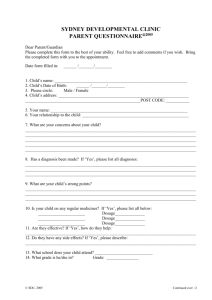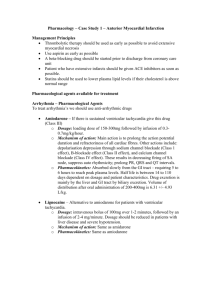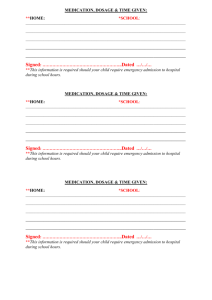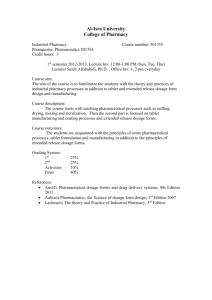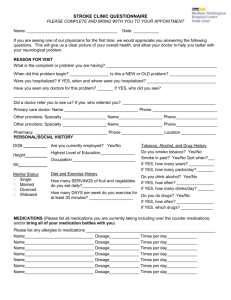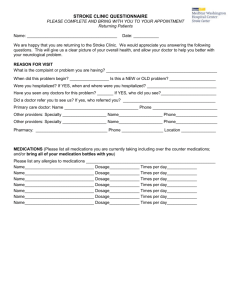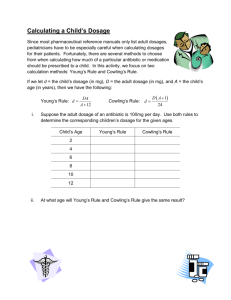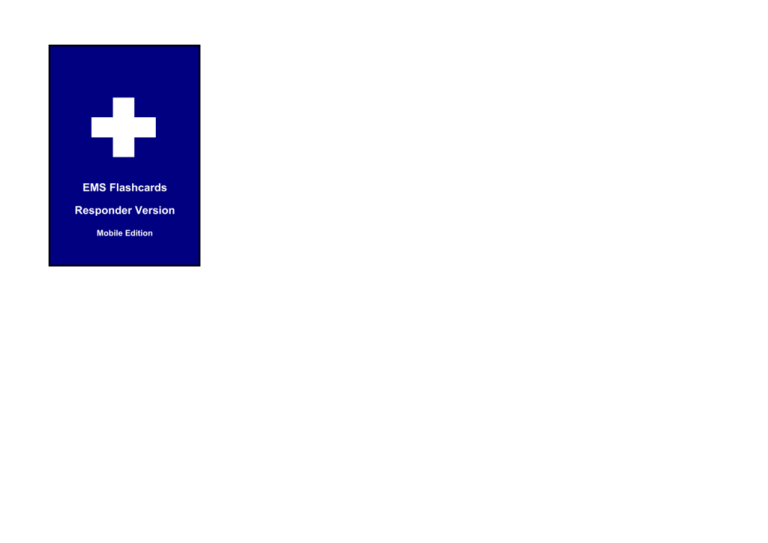
EMS Flashcards
Responder Version
Mobile Edition
EMS Flashcards - Responder Mobile Ver. 2nd Ed January 2011
Author: Alan Batt DipEMS NQEMT-P
alan@emsflashcards.com www.emsflashcards.com
Copyright © 2011 Alan Batt. All rights reserved.
* The information in this publication is considered to be
correct at time of publishing. No responsibility whatsoever is
or will be accepted by the author(s) for any misuse of these
flashcards, or any errors contained within these
flashcards.The author(s) cannot and do not guarantee the
accuracy of information contained within this publication. As
such the user accepts use of this guide is at their own risk.
These are designed to be used by trained personnel only.
Medication dosages and details etc. should always be
confirmed with an official publication. Always practice within
your scope of practice, and follow the current CPGs and
Medication Formulary relevant to your qualification and
approved for use by your service provider. If you discover
any errors in these cards email info@emsflashcards.com.
This publication is not affiliated with nor endorsed by the
PHECC, HSE NAS, DFB or any other statutory, auxiliary,
voluntary or private entity involved in the provision of prehospital care in Ireland.
Acknowledgements: S.Deasy, J.Flahavan, D.Grennan,
R.White, S.Knox, R.Mannion, J.Holland, J.Ward, A.Florish,
L.O'Callaghan, N.O'Leary
Patient Assessment
Primary Survey - Adult
Scene Safety
Universal Precautions
Response - shake & shout
No response - OPA, call for ambulance
Airway - maintain patent
Breathing? adequate?
Oxygen therapy
BLS if necessary
Check circulation
Colour & temp of skin
Cap refill
Control major bleeding
CPR if necessary
Disability
AVPU
Expose & Examine
SAMPLE
Signs & Symptoms
Allergies
Medications
Pertinent past medical
Last Oral Intake
Events leading to illness/injury
OPQRST-A
Onset?
Provokes/Relieves?
Quality
Radiation? Referral?
Severity?
Time? How long?
Associated symptoms?
e.g. nausea, dizziness
AVPU
Alert - answers questions appropriately
Voice - responds to verbal commands
Pain - only responds to painful stimuli
Unresponsive - no response to pain
Baseline Vitals
Pulse (rate,rhythm,strength)
Breathing (rate, rhythm, effort)
Pain score (0-10)
Skin colour, temp, cap ref
AVPU
Temperature
Normal Vital Signs - Adult
Pulse: 60-100bpm, regular
Resp: 12-20 rpm, regular
Skin colour: pink
Skin condition: warm
Temperature: 37.0°C
AVPU: Alert, oriented x 3
Cap refill: <2 secs
Physical Exam
DCAP - BTLS
Deformities
Contusions
Abrasions
Punctures
Burns
Tenderness
Lacerations
Swelling
CSM
Circulation
Sensation
Motor function
Airway Management
Blood pressure
Suction
Yankeur cathether:
Keep tip in sight when suctioning
Soft cath:
Measure as per OPA, mark with
finger, suction as far as this mark
General principles:
Pre-oxygenate patient
Suction on way out
No more than 10 secs
Don't forget to take
Universal Precautions!
Resuscitation
Blood pressure
Cardiac Arrest Algorithm
ADULT
Scene Safety
Standard Precautions
Response - shake & shout
No response - OPA*, call for ambulance
Airway - consider suction*
Check breathing: Not breathing
Provide 2 x ventilations via BVM*
Check circulation
Not present
Witnessed arrest: attach AED pads
Unwitnessed arrest: start CPR
30 compressions: 2 ventilations
Rate of 100 per min
Continue as per CPG
Recognition of Death
Inappropriate to commence
resuscitation when:
1. Death confirmed by Doctor
or
2. Any of the following present:
- Decomposition
- Rigor Mortis
- Incineration
- Decapitation
- Pooling
- Unwitnessed traumatic cardiac arrest
following blunt trauma (5/6.4.13)
- Other injuries totally incompatible with
life
Document with 2 x 10 second rhythm
strips, document on PCR
Mnemonics & Calculators
NATO Phoenetic Alphabet
Alpha
Bravo
Charlie
Delta
Echo
Foxtrot
Golf
Hotel
India
Juliet
Kilo
Lima
Mike
1 – Wun
2 – Too
3 – Thuh-ree
4 – Fower
5 – Fi-yiv
November
Oscar
Papa
Quebec
Romeo
Sierra
Tango
Uniform
Victor
Whiskey
X-Ray
Yankee
Zulu
6 – Six
7 – Se-ven
8 – Ate
9 – Niner
0 – Zero
Oxygen Cylinder Capacity
D Size Oxygen = 340L
@15lpm = 20mins
@10lpm = 34mins
@6lpm = 56min
@2lpm = 2hr 50min
CD Size Oxygen = 460L
@15lpm = 30min
@10lpm = 46min
@6lpm = 1hr 16min
@2lpm = 3hr 48min
F Size Oxygen = 1360L
@15lpm = 1hr 30min
@10lpm = 2hr 15min
@6lpm = 3hr 40min
@2lpm = 11hr 20min
FAST Assessment
F - Facial droop?
A - Arm drift/weakness?
S - Speech slurred?
T - Time to activate EMS
If any of the above are present,
patient is
considered to be FAST positive!
Hospital
Causes of Seizures
Temperature (fever)
Head Injury
Epilepsy
Stroke
Hypoxia
Eclampsia
Drug/alcohol poisoning
Tricyclic Poisoning
Insulin (hypo/hyperglycameia)
Meningitis
THE SHED TIM
Causes of Unconsciousness
Fainting
Infantile Convulsions
Shock
Hypoxia
Stroke
Hypothermia, Hypotension, Heart
Attack
Anaphylaxis, Asthma, Arrest
Poisoning
Epilpetic Convulsion
Diabetes
FISH SHAPED
Causes of confusion
Convulsion [post ictal]
Oxygen [hypoxia, hypercarbia]
Nociception [pain]
Full bladder
Uremia
Sugar [hypo/hyperglycemia]
Infection
Opiates
Natremia [hypo/hyper]
CONFUSION
Spinal Injury
Dangerous Mechanisms
Fall >1m / 5 steps
Axial load to head
MC >100km/h
Rollover or ejection
ATV collision
Bicycle collision
Pedestrian v vehicle
Low risk factors
Simple rear-end MVC
(excludes push into oncoming
traffic or hit by bus/truck)
No neck/back pain
Absence of midline c-spine or
back tenderness
Spinal Innervation
Bones of the skull (frontal)
Bones of the skull (lateral)
Rule of Nines/TBSA % (Adult)
FACE
HANDS
FEET
FLEXION
POINTS
PERINEUM
Don't forget FHFFP!
Weight Conversion
Weight Conversion
PCR Abbreviations
O/A - On arrival
O/E - On examination
C/O - complained of
PMH - past medical history
Sx - Social History
Rx - Treatment
∆ - Diagnosis
< - less than
> - greater than
therefore
CCF - congestive cardiac failure
LVF - left ventricular failure
RVF - right ventricular failure
BBA - born before arrival
DSH - deliberate self harm
PPH - post partum haemorrhage
PERRL - Pupils equal, round,
reacting to light
PCR Abbreviations
°C - degrees celsius
x° - x equals number of hours
x/7 - x equals number of days
x/52 - x equals number of weeks
x/12 - x equals number of months
NSR - normal sinus rhythm
SB - sinus bradycardia
ST - sinus tachycardia
PAC - premature atrial contraction
PVC - premature ventricular contr.
VT - ventricular tachycardia
JR - junctional rhythm
SVT - supraventricular tachycardia
AF - atrial fibrillation
AFL - atrial flutter
FHB - first degree AV block
SHBT1 - second degree AV block T1
SBHT2 - second degree AV block T2
PCR Abbreviations
THB - third degree AV block
ASY - asystole
IDO - idioventricular
PEA - pulsesless electrical activity
- with
? - query
# - fracture
C - cold/cool (in temp obs box)
N - normal (in temp obs box)
H - hot (in temp obs box)
P - palpation (in BP obs box)
R - regular (in pulse obs box)
I - irregular (in pulse obs box)
U - unknown (for any unknown
details on PCR)
NOK - next of kin
Principles of Safe Lifting
1. Assess TILE
Task
Load
Individual Capacity
Environment
2. Bend knees
3. Broad stable base
4. Back straight
5. Firm palmer grip
6. Arms in line with trunk
7. Load close to centre of gravity
8. Pivot feet in direction of
movement
Paediatrics
Blood pressure
Visual Analogue Pain Scale
Rule of Nines/TBSA % (Paediatric)
FACE
HANDS
FEET
FLEXION
POINTS
PERINEUM
Don't forget FHFFP!
Rule of Nines/TBSA % (Infant)
FACE
HANDS
FEET
FLEXION
POINTS
PERINEUM
Don't forget FHFFP!
Major Emergency
Blood pressure
Controllers of Operations
Irish National Grid
Example: S 237 128
Sheet: S
East: 237
North: 128
Read across then up
"In the door and up the stairs"
Major Emergency
Major Emergency
Major Emergency
Major Emergency
Helicopter safety
Only approach after the pilot
has given a clear signal
Helicopter safety
If the rotors are turning, or are
about to turn:
- always approach in pilots visual
field
- approach a helicopter walking
uphill or crouching if level
- never approach a helicopter
walking downhill (main rotor)
- never approach a helicopter
from the rear (tail rotor)
- hold on to all lightweight items
as they may be blown away
- if an item gets blown away do
not chase it - it's not worth your
life
Medication Formulary
Medication Administration
RIGHT medication at the
RIGHT dose through the
RIGHT route to the
RIGHT patient at the
RIGHT time and
WRITE it down
Patient has RIGHT to refuse
Always consider
indications
contraindications
side effects
adverse effects
Always check
expiry date on carton
expiry date on vial/syringe
clarity of medication/fluid
Aspirin (AS)
Dosage & Route (Adult)
300mg PO chew/soluble
Dosage & Route (Paed)
Not indicated
Indications
Cardiac Chest Pain
Suspected AMI
Contra-Indications
Active symptomatic GI ulcer/bleed,
bleeding disorder, KSAR, <16yrs old
Side Effects
Epigastric pain/discomfort,
bronchospasm, GI bleed, GI irritation,
skin reaction, increased bleeding time
Oxygen/O2 (O2)
Inhaled gas
Dosage (Adult)
Titrate to SpO2> 97%
Dosage (Paed)
Titrate to SpO2> 97%
Dosage (COPD)
Titrate to SpO2 88-92%
Indications
SpO2 < 97%; SpO2 <88% (COPD)
Inadequate/absent ventilation
Contra-Indications
Paraquat poisoning
Bleomycin lung injury
Side Effects
Drying of resp tract, airway obtsr if too
dry in paeds. Admin >30mins in paeds should humidify O2
Glucose Gel (GG)
EFR
Glucose gel in tube or sachet
Dosage & Route (Adult)
10-20g buccal
Dosage & Route (Paed)
<8yrs: 5-10g buccal
>8 yrs: 10-20g buccal
Indications
Known diabetic with confusion or altered level
of consciousness.
Contra-Indications
KSAR
Side Effects
Vomiting in <5y if admin too quickly
Additional Info
Will maintain glucose levels once raised but
should be used 2° to Dextrose or Glucagon to
reverse hypoglycaemia.
Salbutamol (SA)
EFR
Inhaled nebuliser
Dosage (Adult)
0.1mg metered aerosol spray x 2
Dosage (Paed)
0.1mg metered aerosol spray x 2
Indications
Bronchospasm
Resp distress following submersion
Contra-Indications
KSAR
Side Effects
Tachycardia, tachyarrythmias, tremors
Glyceryl trinitrate (GT)
EFR
GTN
Dosage & Route (Adult)
0.4mg SL MAX
Dosage & Route (Paed)
Not indicated
Indications
EFRs may assist with admin of GTN
to angina or suspected AMI patients
Contra-Indications
SBP <90mmHg, sildenafil or other use
<24hr, KSAR
Side Effects
Headache, hypotension, flushing,
dizziness

